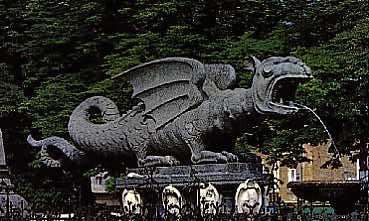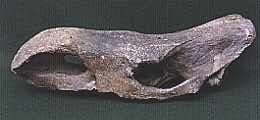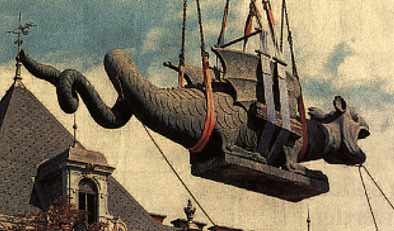

| Whenever you come to Austria, visit Klagenfurt, the capital of Carinthia. There you will find the famous Lindwurm monument, which was errected by Ulrich Vogelsang in 1590. Although it represents a dragon, it can be regarded as the first palaeontological reconstruction. |  |
 |
In 1335 the cranium of a wooly rhinoceros from the ice-age was found in a gravel pit near Klagenfurt. It was instantly interpreted as the skull of a dragon or Lindwurm. This fossil, which is still at exhibition at the Landesmuseum für Kärnten, served as a model for the head of the Lindwurm. |

|
"Das Wahrzeichen von Klagenfurt ist am Dienstag flügge geworden. Der Lindwurm des gleichnamigen Brunnens wird allerdings nicht zur Luftaufklärung bei der Makakenjagd eingesetzt, er soll vielmehr bis 1997 renoviert werden." |
Source:
ABEL O. (1939): Vorzeitliche Tierreste im Deutschen Mythus, Brauchtum und Volksglauben. - 304 p., Jena (Gustav Fischer).
MC BEATH, A. (1998): Trans-Alpine Dragon Hunt. - The Dragon Chronicle, vol. 12, London.
PUSCHNIG, R. (1936): Der "Lindwurmschädel" von Klagenfurt. Carinthia II, vol. 125/45, Sonderdruckreihe 1/35.
UCIK, F.H. (1990): Wollnashorn und Lindwurm. Einige Betrachtungen über das Symbol unserer neuen Vereins-Buchreihe. - Carinthia II, vol. 180/100, p. 295-306, Klagenfurt.
Photo of the fossil rhinoceros cranium courtsey of Dr. G. Piccottini,
Landesmuseum für Kärnten, Klagenfurt.
Flying Lindwurm: © Text: Der Standard 10.09.1996, © Photo: APA/Fritz Press
© MCMXCVI by J. Georg Friebe
& Vorarlberger Naturschau, Dornbirn (Austria)
last update: 18.04.1999